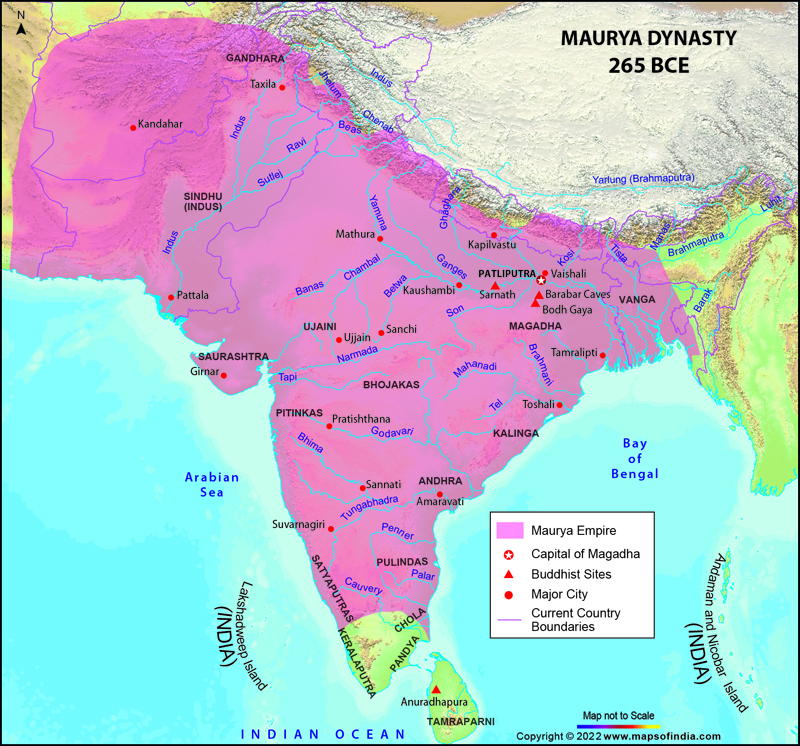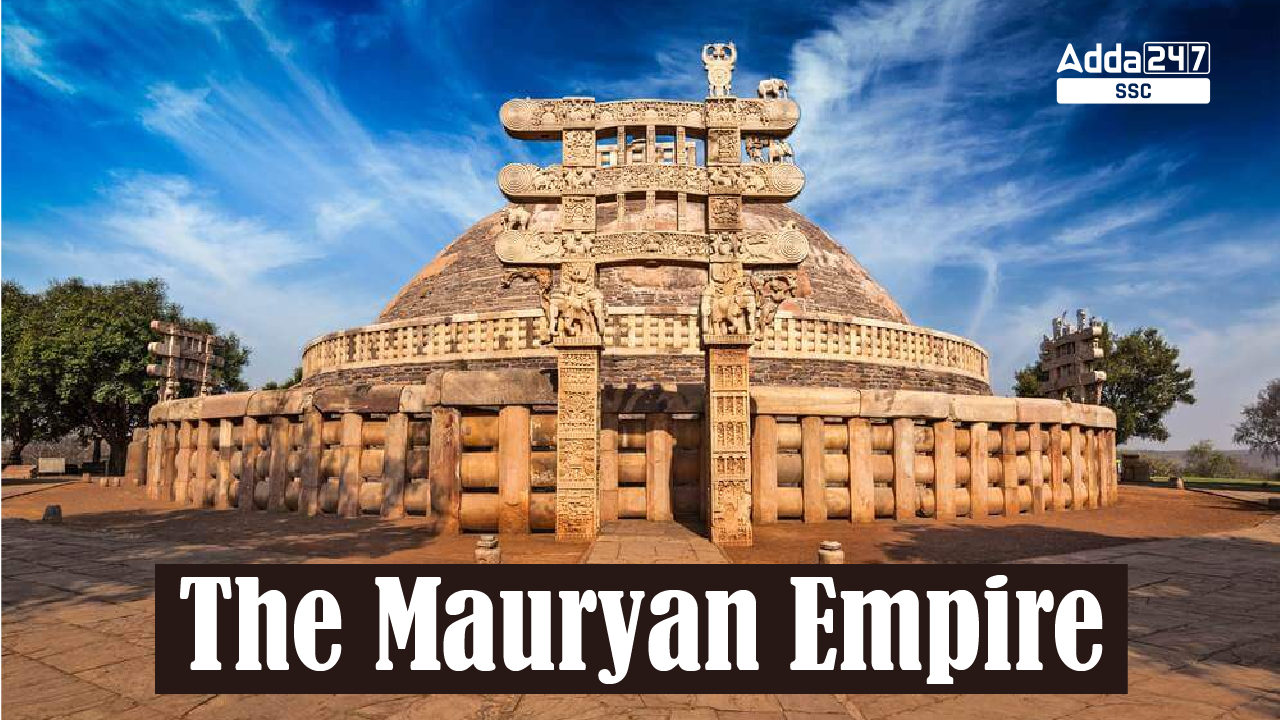Table of Contents
Mauryan Empire
The Mauryan Empire: The Mauryan Empire was the first pan-Indian empire. It covered a large area of the present Indian region except for Kerala, Tamil Nadu, and some parts of northeastern India, though it was centered around Magadha. Its boundary reaches parts of modern-day Iran. The empire was characterized by a strong central government, an efficient administrative system, and a well-organized army. They also had fair rules and laws, a system for measuring things that were the same everywhere, and they helped spread Buddhism.
The Mauryan Empire History
The Mauryan Empire was founded by Chandragupta Maurya with the help of Kautilya. The Mauryan empire was established in 321 B.C.E. and continued till 185 B.C.E. Alexander’s death in 323 B.C.E. left a large power vacuum, and Chandragupta took advantage, gathering an army and overthrowing the Nanda dynasty in Magadha, in present-day eastern India, marking the start of the Mauryan Empire. After crowning himself king, Chandragupta took additional lands through force and by forming alliances.
Chandragupta’s chief minister Kautilya, also called Chanakya, advised Chandragupta and contributed to the empire’s legacy. Kautilya is also known for writing the Arthashastra, which describes how a state should organize its economy and maintain power.
During Emperor Ashoka, the empire was expanded to its biggest on the Indian subcontinent, spanning more than five million square kilometers. It was surrounded on three sides by mountains: the Himalayas, the Ganges River to the north, the Bay of Bengal to the east, the Indus River, and the Arabian Sea to the west. Patliputra, which resembles modern-day Patna in Bihar, was the capital of the Mauryan empire.
Mauryan Empire Map
The territorial extent of the Mauryan Empire can be seen in the given map:
It spans more than five million square kilometers. It was surrounded on three sides by mountains: the Himalayas, the Ganges River to the north, the Bay of Bengal to the east, the Indus River, and the Arabian Sea to the west as can be seen in the map.

Mauryan Empire Flag
Below, you can view the flag of the Mauryan Empire.

Rulers of the Mauryan Empire
Let’s examine the rulers who governed the Mauryan Empire below.
Chandragupta Maurya
Chandragupta founded the Mauryan empire. He was supported by Chanakya. Chandragupta embraced Jainism towards the end of his life and stepped down from the throne in favor if his son, Bindusara. According to Jain texts, Chandragupta Maurya adopted Jainism and went to the hills of Shravanabelagola (near Mysore) and committed Sallekhana (death by slow starvation).
Bindusara
Bindusara, the second monarch of the Mauryan Dynasty, was the offspring of Chandragupta Maurya. Also recognized as Amitraghata, which translates to “killer of enemies,” he held dominion over a significant expanse of India, skillfully unifying 16 nations beneath the Mauryan Empire. Bindusara adeptly annexed the region stretching from the Arabian Sea to the Bay of Bengal, effectively establishing Mauryan influence across much of the subcontinent.
Notably, Bindusara cultivated harmonious diplomatic ties with the Greeks, with Deimachus serving as the envoy from the Seleucid emperor Antiochus I to Bindusara’s court.
Among his numerous spouses, Bindusara is believed to have fathered around 16 sons, including the renowned figure, Ashoka. Contrary to being the eldest, Ashoka, according to the Buddhist account of Ashokavadana, was designated as the governor of Ujjain during Bindusara’s rule. Following Bindusara’s demise, Ashoka ascended to power as the third Mauryan emperor.
Although historical records provide limited insight into Bindusara’s personal life and achievements, his reign significantly contributed to the expansion and consolidation of the Mauryan Empire. This laid a crucial foundation for the illustrious rule of his notable son, Ashoka.
Ashoka
Ashoka was a the greatest king of the Mauryan empire. As king, he was forceful and ambitious,
reinforcing the Empire’s dominance in southern and western India. However, his victory over Kalinga (262-261 BCE) was set out to be a defining moment in his life. After Kalinga war, looking at the devastation and violence, he decided to abjure violence and follow the path of Ahimsa.
Ashoka put the tenets of Ahimsa into practice by repealing sports like hunting and putting an end to forced labour and indentured slavery. The Dhamma Vijay policy also placed a strong emphasis on non- violence, which was to be observed by denying war and conquests as well as by refusing the death of animals.
After Ashoka, a series of less powerful rulers served. Dasharatha Maurya, the grandson of Ashoka, succeeded him. His first child, Mahinda, was intent on making Buddhism popular everywhere. Due to his eye defect, Kunala Maurya was not good at taking the enthrone, and Tivala, the descendant of Kaurwaki, passed away even before the death of Ashoka. Jalauka, another son, has a relatively uneventful backstory of life.
Under Dasharatha, the Empire lost a great deal of land, which Kunala’s son Samprati eventually took to recover.
Brihadratha
Brihadratha was the last ruler of the Mauryan dynasty, who reigned from around 187 BCE to 180 BCE. He was the grandson of Emperor Ashoka and the son of Ashoka’s son, Kunala.
Brihadratha’s reign was marked by political instability and internal strife, as many of his ministers and governors sought to increase their own power at the expense of the central government. According to tradition, Brihadratha was eventually assassinated by his own minister, Pushyamitra Shunga, who then established the Shunga dynasty and became the new ruler of India.
Brihadratha’s reign marked the end of the Mauryan Empire, which had once been the most powerful empire in India. Despite the decline and eventual fall of the Mauryan dynasty, the empire’s legacy continued to influence Indian culture and society for centuries to come. The period of Mauryan rule was marked by significant advancements in art, architecture, literature, science, and philosophy, as well as the spread of Buddhism throughout India and beyond.
Decline of the Mauryan Empire
Ashoka’s rule came to an end in 232 BCE, marking the start of the Mauryan empire’s decline. A number of events were responsible for the demise of a huge empire. They include:
Economic crisis: The Mauryan empire maintained a huge army, resulting in significant expenditures for paying the soldiers and officials, which burdened the Mauryan economy. Ashoka opposed the killing of animals and pets. The Brahmanical society, which depended on the offerings made in the name of sacrifices, suffered due to Ashoka’s anti-sacrifice attitude. As a result, the Brahmanas formed some sort of animosity toward Ashoka.
Dissemination of new knowledge: This material knowledge acquired from the Magadha served as the foundation for the founding and expansion of other kingdoms like the Shungas, Kanvas, and Chetis.
Ignorance of North-West Frontier: Ashoka was involved with both domestic and international missionary endeavors. It left the northwest frontier open to invasions. Also, successive rulers were not capable enough to safeguard its boundaries.
Pushyamitra Shunga finally brought an end to the Mauryan empire and established the Shunga dynasty.
| You may also like to read: | |
| Major Rock Edicts of Ashoka | National Animal of India: Royal Bengal Tiger |
| Important lakes of India |
National Emergency Definition, Introduction, Types: Article 352 and FAQs |



 SSC CGL 2025: Will the Number of Vacanci...
SSC CGL 2025: Will the Number of Vacanci...
 RRB ALP Preparation Strategy 2025, Tips ...
RRB ALP Preparation Strategy 2025, Tips ...
 SSC CGL 2025: Why It Will Be the Most Co...
SSC CGL 2025: Why It Will Be the Most Co...


